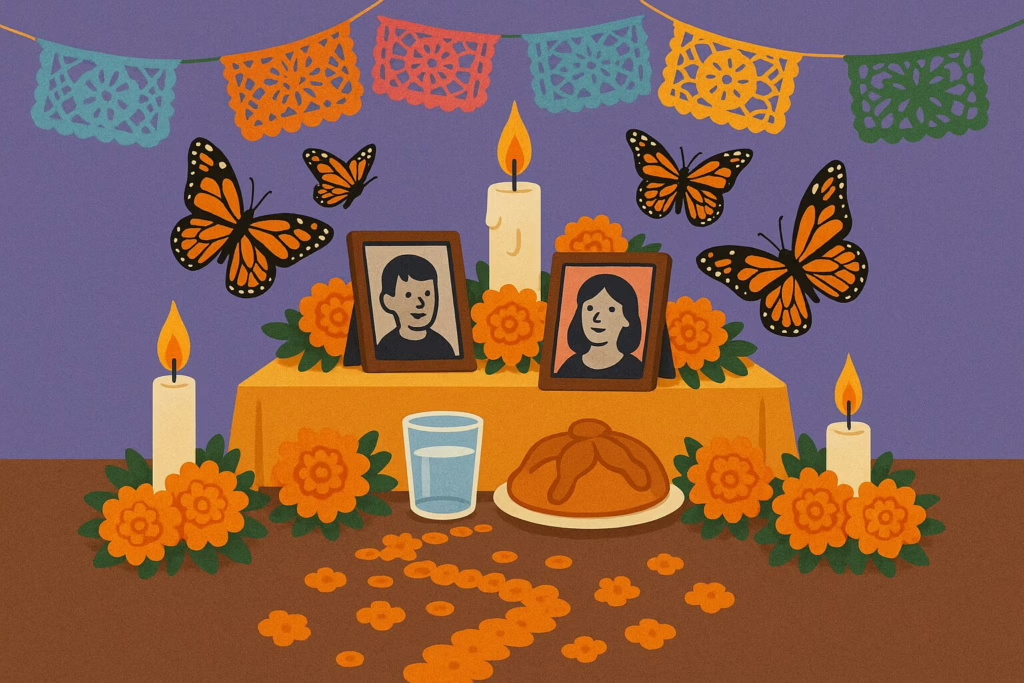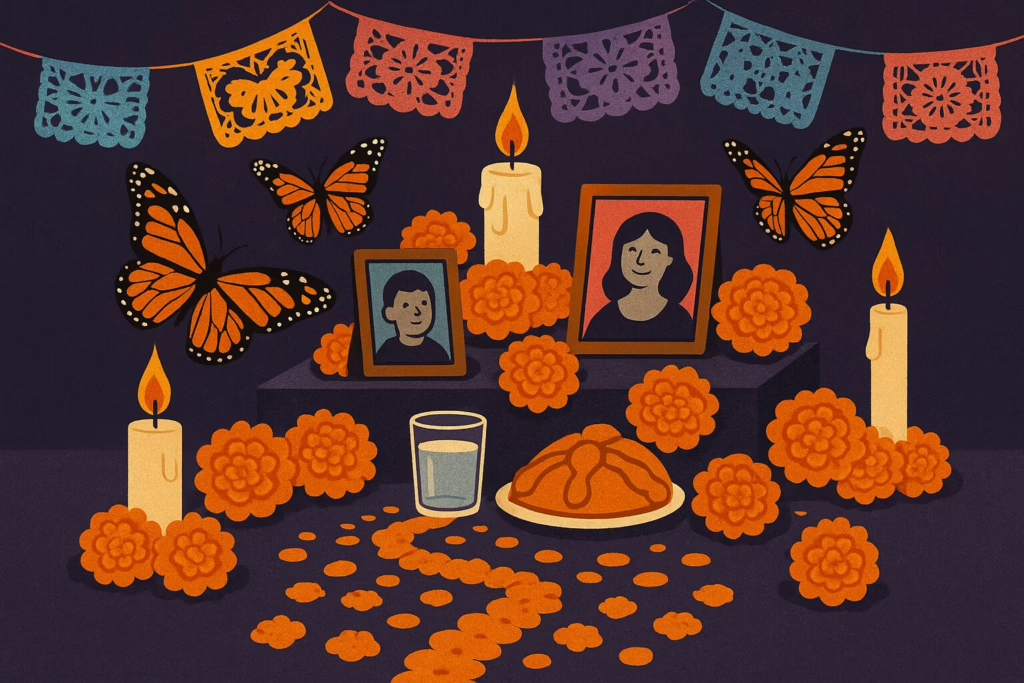Day of the Dead is a Mexican tradition on November 1 and 2 that welcomes the spirits of loved ones with home altars, marigolds, candles, and favorite foods. Find out how “small messengers” like monarch butterflies and hummingbirds, plus ofrenda symbols, guide ancestors home and signal their presence.
What this guide will help you find out
- What each day means, November 1 versus November 2
- Why marigolds, candles, water, and bread appear on ofrendas
- How “small messengers” like butterflies, hummingbirds, and even paper flags are read as signs
Focus keyword: Day of the Dead meanings
Long-tails: Día de los Muertos symbols, monarch butterfly Day of the Dead, ofrenda elements and meanings
The dates and their meanings
November 1: Often called Día de los Inocentes or Día de los Angelitos, families honor children who have died.
November 2: The day for deceased adults, marked by cemetery visits, music, and shared meals.
These observances blend Indigenous worldviews with Catholic All Saints and All Souls, centering remembrance over fear. Wikipedia+1

The ofrenda, explained
An ofrenda is a home altar built to welcome specific ancestors, not a general memorial. Most include the four elements and guiding symbols:
- Marigolds (cempasúchil): Bright color and strong scent create a path that helps souls find their way. Petals often mark a trail from door to altar. Smithsonian Magazine+1
- Candles: Light that guides; many arrange them in four points for the cardinal directions. thegracemuseum.org
- Water: A glass or pitcher to quench a spirit’s thirst after a long journey. thegracemuseum.org
- Food and pan de muerto: Favorite dishes and a lightly sweet bread stand for earth and hospitality. thegracemuseum.org
- Papel picado: Cut-paper flags that move with the wind, signaling presence and the fragility of life. thegracemuseum.org+1
- Photos and mementos: A direct invitation to the loved one you hope to host. hechoonline.org
Small messengers: how nature carries messages
In many regions, people read quiet arrivals as signs that the invitation worked. Here is what to look for and what people say they mean.
Monarch butterflies
Arriving in central Mexico each late fall, monarchs are seen as carriers of souls, a living reminder that the dead return along invisible routes. When butterflies linger on marigolds, many read it as a loving visit. hechoonline.org+1
Hummingbirds and songbirds
Quick flashes at windows, hovering near flowers, or pausing by the altar are read as brief greetings, especially for elders who loved gardens. Interpretation varies by family, yet the meaning is consistent: someone remembered found the way. (This is a cultural reading that accompanies, not replaces, ecological facts.) pbs.org
Moving papel picado
A sudden flutter when the room is still can feel like a hello. The paper’s movement stands in for wind, one of the classical elements on the altar. thegracemuseum.org+1
These signs are symbolic, not supernatural proof. They help families find out that remembrance is active: you called, and someone answered.
Alebrijes: art, guides, and what’s traditional
Colorful alebrijes are modern folk art, popularized in Mexico City in the 1930s and later carved in Oaxaca. Many people now display them as spirit guides, and films have amplified that idea, but they were not originally part of Day of the Dead practice. Use them respectfully, knowing you are blending traditions. Wikipedia+1
How to build an ofrenda at home (quick steps)
- Choose who you are inviting. Add a photo and a favorite item. hechoonline.org
- Set the four elements. Water, a candle, food or bread, and papel picado. thegracemuseum.org
- Lay a marigold path. Petals from the entrance to the altar if possible. Smithsonian Magazine
- Add scents and sounds. Copal incense and a small bell help guide the way. Smithsonian Magazine
- Visit and share. On Nov 1–2, tell stories, play favorite music, and share the food after. pbs.org
Check your work:
Are the four elements present? Is the person identifiable by photo or mementos? Is there a safe candle plan? Did you include at least one item they loved?
celebrate respectfully
Across the United States, museums, schools, and neighborhoods host public altars, workshops, and parades. Participation should be guided by learning, not costume, and by crediting the Mexican communities who keep these traditions alive. Look for local cultural centers or families who invite the public to find out more and take part in educational ways. pbs.org

FAQ
What are the exact dates?
November 1 for children, November 2 for adults. Some areas begin the evening of October 31. Wikipedia+1
Is this the same as Halloween?
No. Day of the Dead honors and welcomes loved ones, it does not focus on fear or scares. pbs.org
Why marigolds everywhere?
Their color and scent mark a path that helps ancestors find the altar. Smithsonian Magazine+1
Are alebrijes required?
No. They are beloved folk art that many include, but not a historic core practice. Wikipedia
What counts as a “sign” that someone visited?
Butterflies, hummingbirds, candle flickers, or moving papel picado are read as symbolic greetings. hechoonline.org+1
Conclusion
Day of the Dead is a living tradition that teaches remembrance through action. Build an ofrenda with care, watch for the small messengers, and find out how memory turns a home into a welcome. In honoring the dead, the living community becomes stronger.
Sources
- Wikipedia, “Day of the Dead.” Overview, dates, context. Credibility: Wikipedia
- PBS NewsHour, “What is Día de los Muertos?” Holiday explanation and dates. Credibility: pbs.org
- Smithsonian Magazine, “Meaning Behind Six Objects on Día de los Muertos Altars.” Marigolds, copal, bells. Credibility: Smithsonian Magazine
- Cibolo Nature Center, “Marigolds: A symbolic flower.” Cempasúchil symbolism. Credibility: The Cibolo Center for Conservation
- The Grace Museum, “Symbols and Traditions.” Four elements of ofrenda. Credibility: thegracemuseum.org
- HECHO, “Monarch butterfly and Día de los Muertos.” Monarch belief and altar basics. Credibility: hechoonline.org
- Wikipedia, “Alebrije.” Origins and relation to the holiday. Credibility: Wikipedia
- Lolo Mercadito, “Monarch Butterflies, Spirits of Día de Muertos.” Contemporary reading of signs. Credibility: Lolo – Modern Mexican Mercadito
